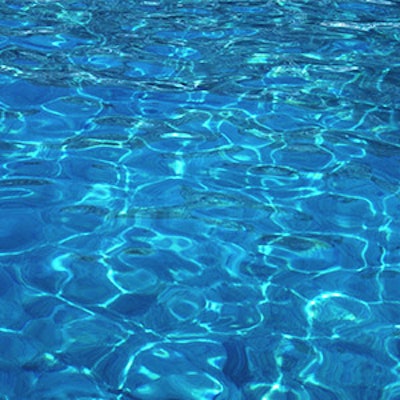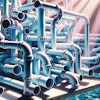
For nearly two decades I have been spec'ing UV sterilizers, all the while never fully understanding how to select the correct device for each situation. Manufacturers have beautiful colorful brochures and detailed operational manuals, but for all of my experience and education, I still needed UV explained to me in simple terms.
So I called Marty Fisher, U.S. commercial sales manager for Delta UV, to enlighten me. I've learned to trust Marty's knowledge on a range of subjects, and with his recent work educating the industry on the specifics of proper UV use, he seemed a perfect choice for my query. What he provided was a crash course in understanding what UV really is and how to navigate the various devices on the market.
I started by asking him to define what UV really is and how it affects the water in our projects. I knew of UVA and UVB light from suntan lotion labels, but I learned that our industry utilizes UV-C to treat the water we swim in. {bglink 5142}
As public health codes have started to demand UV as a water sterilizer and the market has begun to expand, the topic is coming up more often at my company. New York State requires UV for public pools, waterparks, splash pads and other public baths and California mandates a complicated set of rules for all interactive water feature installations in every county in the state. I knew there was a need to update my knowledge base on these vital products and why we need them.
My biggest misconception about UV was that it actually kills pathogens like algae, bacteria and viruses. Actually, UV's primary function is to sterilize by scrambling the DNA of these microorganisms so they cannot propagate and grow. UV is often used as a partner to halogens like chlorine and bromine since it can reduce halogen use, and therefore reduce the formation of chloramines and bromamines as well.
Marty clarified another large misconception that I had about the pressure rating of UV units. I assumed that this referred to the pressure of the operating water system but he set me straight — it is the internal UV bulb pressure. The higher the pressure, the more costly the system, but the more it can do for a project. So medium-pressure bulbs are more effective at eliminating chloramines than lower pressure, but at a price.
MAKING DOLLARS AND SENSE
Another big economic question is why to use UV at all in our water projects if chlorine is such an effective sanitizer? Marty's easy answer is cost, but just as important is its ability to reduce cryptosporidium, legionella, streptococcus, algae and many other bacteria and viruses.
After doing the math on bulb replacement versus the costs of buying chlorine, we figured out that the financial benefits weigh in favor of UV for appropriate bodies of water. Besides, lowering the levels of chlorides in water has a widespread benefit to water quality and costs savings.
The moral of this story is that UV is a tremendous partner to other stable halogens that stay persistent in water when a mechanical system turns off periodically. Besides the growing legal requirements for its use, there are plentiful reasons to apply this expanding technology in water projects.
Personally, after Marty's explanations of the benefits and how best to spec units, we are now likely to see more UV units on our projects. This may sound like a commercial or endorsement, but it is really just the result of the education we've received. Now that we know more about UV, we can use it more effectively, which in turn enhances our level of professionalism. I find we're doing better work because we have finally got our UV programming right.
On the other hand, not every project is right for UV. If you do the math, it becomes a little overwhelming in very small bodies of water. For example, in a 20,000 gallon public pool with moderate to low bather loads, these effective UV units are underutilized. If the bather loads or water volumes increase, so does the need for UV, and very quickly.
That said, it remains challenging for many property owners to agree to the cost of installing the unit in the first place. What they may not understand is the thousands of dollars that they will save in halogen sanitizer during the year, which quickly offsets that initial cost, plus a couple hundred dollars every two to three years to replace a UV bulb.
Another consideration is the reduction in the frequency that pools need to be drained down due to water chemistry problems or high TDS.
CORRECT SPECIFICATIONS
Selecting the proper UV unit for a given application is perhaps the biggest consideration. For the most basic of public swimming environments — a simple one-pump, one-filter system with a small chlorine erosion sanitizer — which is about 90 percent of public pools in the nation, a low-pressure unit may be sufficient.
We need some more details to make this specification fit, including the flow rate of the UV system, which is about 106 gpm. Other factors include bather load in a worst-case scenario, indoor or outdoor equipment application and whether the vessel is a specialty item like a lazy river or splash pad.
A medium-pressure stainless-steel unit would be overkill and double the cost at a minimum. If a similar situation is contemplated but with the need for a three-pump, three-filter setup, then the medium-pressure stainless UV unit is desirable, due to demand. Municipal, high bather load or settings where chloramine knockdown is required almost demands that a stainless UV unit be implemented. If you add the need to sterilize cryptosporidium, as is the case with a splash pad, then UV is absolutely necessary.
Placement of the UV system is another issue. In typical installations, it should be last on the discharge line (but before chemical injection points) back to the vessel.
Does the unit need to be National Sanitation Foundation certified? My opinion, regardless of agency requirements, is that anytime there will be humans in connection with the water of a project, NSF certification is a necessity. Think of the legal ramifications if we all specified a non-NSF unit and someone got ill. Whether the certification actually changes the device in any way, we all need to protect ourselves against litigation. Don't save a few thousand dollars by specifying or buying a non-NSF unit when there are bathers involved. The results could be financially tragic. I consider it good insurance.
I started using UV in a biological pond system many years ago due to the benefits of sterilization without the use of chlorine for plants and fish. Most all of our biological environments have UV on them for this reason. Ponds still require water plant assistance to generate acceptable water quality. Holdenwater recently designed and managed a large vessel that had this same setup, but the project owners delayed the installation of the aquatic plants, which created a very unhealthy situation for the water. The upshot: We've learned that we always need to make sure we know exactly what the builders and clients intend for a project.
Maintenance is another point to consider when evaluating UV sterilizers for a project. Many times, service technicians lack the background or gumption to address the needs of a UV system. Some gravitate toward shocking a body of water instead of truly analyzing the needs of the water. This happens more times that we would like to admit. So anyone implementing a UV system has a responsibility to educate as well as install or design the system.
Although UV units have the same light spectrum as the sun puts out, they prefer to be installed under cover. High-end UV sterilizers can handle adverse environmental conditions, but most commercially rated devices demonstrate greater longevity when protected from direct exposure to the elements. As such, we typically either install the controls indoors or inside a weatherproof enclosure.
MAINTENANCE CONCERNS
Every great invention has a need for human intervention. If we leave UV units unattended indefinitely, they appear to operate but actually are not helping in any way. This is why California has added regulation that mandates all UV sterilizer units on interactive features have sensors to shut down when the UV millijoules value falls below a threshold level of 40 mj. And they likewise require automatic wiper devices to clean the quartz sleeves that house the bulbs from the buildup that occurs on the inside surface.
Lastly, health departments and other vested authorities in California now mandate the systems have alarms to alert service technicians of a nonoperational situation and to promote the changeout of bulbs to keep up the UV functionality, which as we have seen, is a crucial component of the overall clean-water regimen.
Comments or thoughts on this article? Please e-mail [email protected].







































